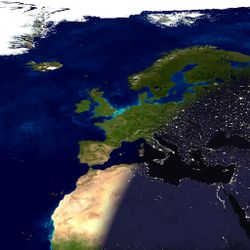نهار
(تم التحويل من النهار)
للاستخدامات الأخرى، انظر Daylight (توضيح).
النهار هو الفترة الزمنية بين شروق الشمس وغروبها. يعتمد طول النهار على كل من العرض الجغرافي مكان الرصد وفصول السنة. فعلى خط الاستواء، يستمر النهار 12 ساعة. أما في الأماكن الأخرى فيطول عن ذلك أو يقصر حسب فصول السنة، ويبلغ 12 ساعة فقط عند الاعتدالين. وأطول نهار بالنسبة للعروض الشمالية يكون في وقت الانقلاب الشتوي، حوالي 21 ديسمبر، وأقصر نهار في الانقلاب الصيفي، حوالي 21 يونيو، والعكس للعروض الجنوبية.
شدة ضياء النهار في مختلف الحالات
| استضاءة | مثال |
|---|---|
| 120,000 lux | Brightest sunlight |
| 110,000 lux | Bright sunlight |
| 20,000 lux | Shade illuminated by entire clear blue sky, midday |
| 10,000 - 25,000 lux | Typical overcast day, midday |
| <200 lux | Extreme of darkest storm clouds, midday |
| 400 lux | Sunrise or sunset on a clear day (ambient illumination). |
| 40 lux | Fully overcast, sunset/sunrise |
| <1 lux | Extreme of darkest storm clouds, sunset/rise |
وللمقارنة، فإن مستويات ضياء الليل هي:
| استضاءة | مثال |
|---|---|
| <1 lux | Moonlight[1] |
| 0.25 lux | Full Moon on a clear night[2][3] |
| 0.01 lux | Quarter Moon |
| 0.002 lux | Starlight clear moonless night sky including airglow[2] |
| 0.0002 lux | Starlight clear moonless night sky excluding airglow[2] |
| 0.00014 lux | Venus at brightest[2] |
| 0.0001 lux | Starlight overcast moonless night sky[2] |
For a table of approximate daylight intensity in the Solar System, see sunlight.
التأثير
انظر أيضاً
- النهار القطبي
- Twilight
- Moonlight
- Daylight saving time
- Daylighting
- Daytime (astronomy)
- Right to light
- Day length
الهامش
- ^ Bunning, Erwin (1969). "Interference of moonlight with the photoperiodic measurement of time by plants, and their adaptive reaction" ([dead link] - Scholar search). Proceedings of the National Academy of Sciences of the United States of America. 62 (4): 1018–1022. Bibcode:1969PNAS...62.1018B. doi:10.1073/pnas.62.4.1018. PMC 223607. PMID 16591742. Retrieved 2006-11-10.
{{cite journal}}: External link in|format=|coauthors=ignored (|author=suggested) (help); Unknown parameter|month=ignored (help)[dead link] - ^ أ ب ت ث ج Paul Schlyter, Radiometry and photometry in astronomy FAQ (2006)
- ^ "Petzl reference system for lighting performance". Archived from the original on 2008-06-20. Retrieved 2007-04-24.
وصلات خارجية
- Royal Institution of Chartered Surveyors - Rights to Light Determination Homepage
- Daylight Chart shows sunrise and sunset times in a chart, for any location in the world.
- http://www.gandraxa.com/length_of_day.xml Deriving the formulas to calculate the length of day.
This article contains content from Wikimedia licensed under CC BY-SA 4.0. Please comply with the license terms.



